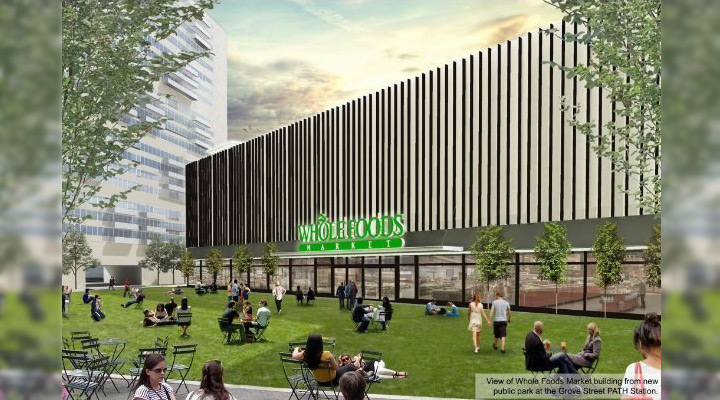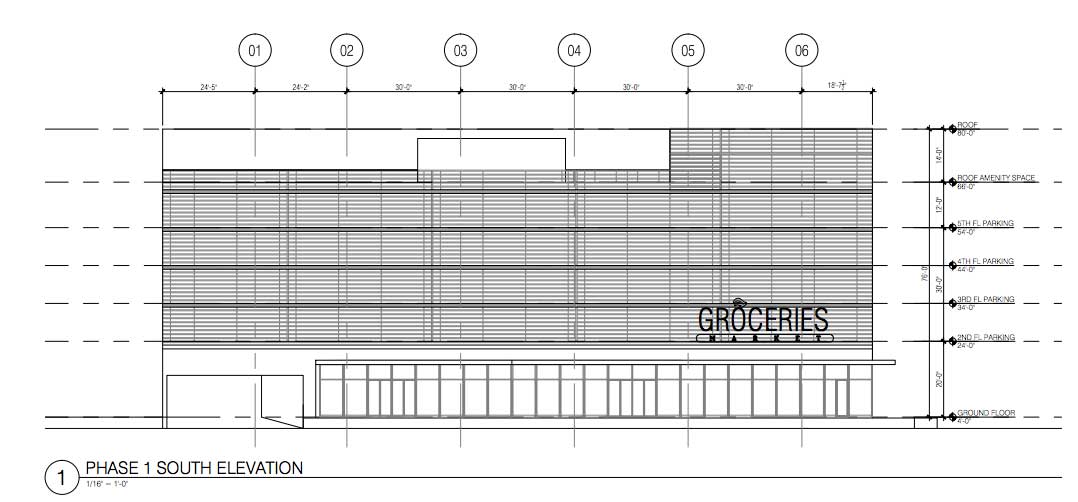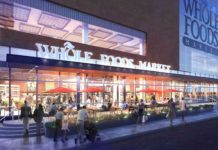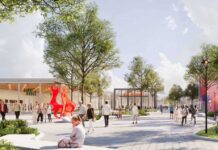
When the Whole Foods announcement was made, information on the project was scarce. Other than a general idea of its location, nothing further was released. Last night, the architect and attorney representing the project presented the proposed site plan to the Harsimus Cove Association and Van Vorst Park Association.
A representative from Studio V Architecture started the presentation with a brief history of the site. Prior to the site’s current incarnation, Newark Avenue extended beyond Marin Blvd and cut diagonally through where Metropolis Towers sit today. For much of its existence, the area was an active retail corridor bustling with small shops much like Newark Avenue a few blocks west. In the 1950-60’s a new urban renewal trend became popular that involved creating superblocks, where planners compiled multiple city blocks, removed the intersecting streets, and created a large continuous block. Stuyvesant Town in Manhattan is a prime example of superblocks.
That’s precisely what happened on the Metropolis Towers site. Streets were removed to create a superblock with two housing towers and a large surface parking lot. According to various reports, Metropolis Towers was the first urban renewal project in the US.
Now, the needs of the city and residents have changed and it’s time for a new urban renewal project for the site.
There are two existing co-op residential towers on the site that will remain. It’s actually the owners of these co-op units developing the project.

Studio V’s plan for the project was inspired by the site’s original layout. They envision, a pedestrian only street dissecting the site near where Newark Ave once had. This thoroughfare was once a lively retail corridor and that’s what they want to recreate. Eventually, both sides of the pedestrian walkway would have active retail spaces. Whole Foods is fully onboard with the active street concept too, promising a cafe with outdoor seating and potentially other concepts.
One major obstacle of this walkway is that it dissects the existing eastern tower. In an effort to avoid walking around the building, the architect proposed having the walkway cut through the middle of the building by demolishing the current lobby. Pedestrians on the path could then walk right through the building.
The proposed project has two phases. The first is the Whole Foods building and the second will be a residential component. Both the attorney and the architect emphasized the focus on phase one as phase two is too speculative for the time being but due to legal reasons, it needs to be included in the phase one site plan.

Phase one is pretty straight forward. If involves constructing one 5-story building, the pedestrian walkway, and an adjacent park. The building will house a 45,825 square foot Whole Foods on the ground level and have 4 stories of parking above it. The roof of the structure will be an amenity space for the co-op residents.



The parking structure will accommodate 544 parking spots, 234 of which will be reserved for Whole Foods and the remainder for the co-op residents. It will be wrapped with a decorative metal mesh to hide the parking decks.
The project utilizes the existing entrances to Metropolis Towers on Montgomery Street for both vehicular and truck traffic.
Another highlight of the proposal is a plan to elevate the entire site above the flood plane and use various technologies to manage and mitigate storm water.
As far as the timeline is concerned, representatives were hesitant to give any binding dates. Roughly speaking, they plan to have permits approved by the end of the year and likely have shovels in the ground next spring. Construction of the actual building is expected to take 18 months, after which Whole Foods would begin their buildout. In total, they estimated a 30-month total timeline for first phase of the project.
For the most part, the community members in attendance appeared impressed with the project. However, a resounding concern among most residents was the increased traffic load the project is bound to inflict. Studio V’s representative attempted to down play traffic concerns by highlighting how transit-oriented the project is. It’s above the PATH stations, near Citibike stations, and near the light rail. His theory was that all these options will minimize shoppers accessing the store by car.
The architect met with the City on numerous occasions, specifically the Planning Board and the Traffic Department. He pointed out that Planning had “absolutely no concerns with the traffic impact” and the Traffic Department “had no questions”. Some unnamed City officials went as far as to say the project would improve traffic in the area, according to the architect. Both statements were met with sneers from the audience.
There’s no doubt in anyone’s mind this project will further exacerbate the already horrid traffic situation along Marin Blvd, Christopher Columbus Drive, and Montgomery Street. Where traffic patrol officers are already stationed most of the time. Looks that those will become permanent posts.
Another concern was the loading and unloading of delivery trucks. The architects have configured the loading area to be completely on site in a dedicated section of the building. Whole Foods has strict requirements for their loading docks to cut down on noise, pollution, and waste.
The project looks promising. As the architect highlighted numerous times, they’re taking a private surface parking lot that’s currently surrounded by a chain link fence and creating a mix of public and private spaces filled with active store fronts. Also, with the design paying tribute to the original layout of the site, the project looks to undo some of Jersey City’s urban planning failures from decades past. If the traffic can be mitigated, the project will certainly be an upgrade from what’s currently there.
What’s your opinion on the proposal? Sound off in the comments.
A request for more renderings of the project went unanswered.


